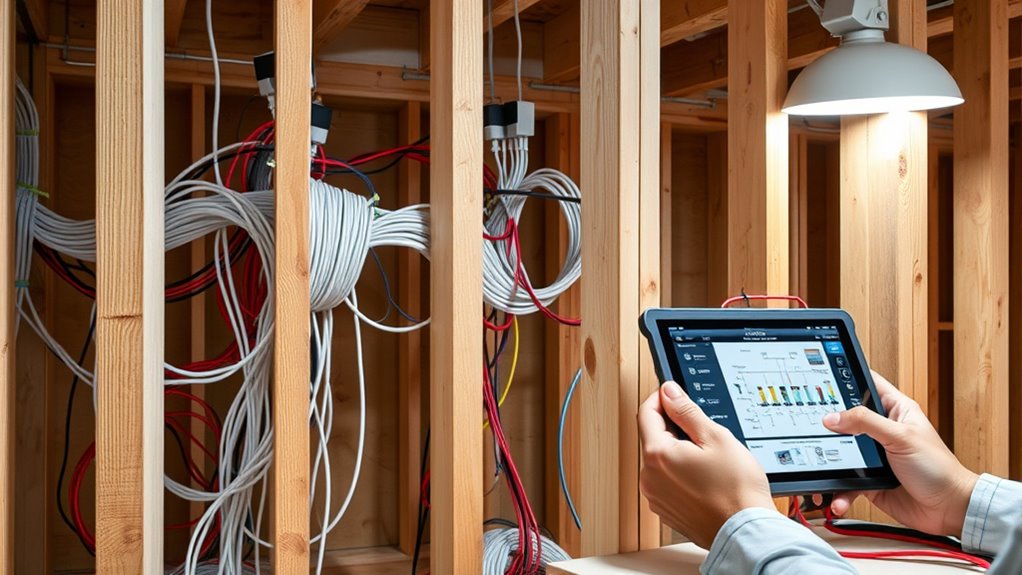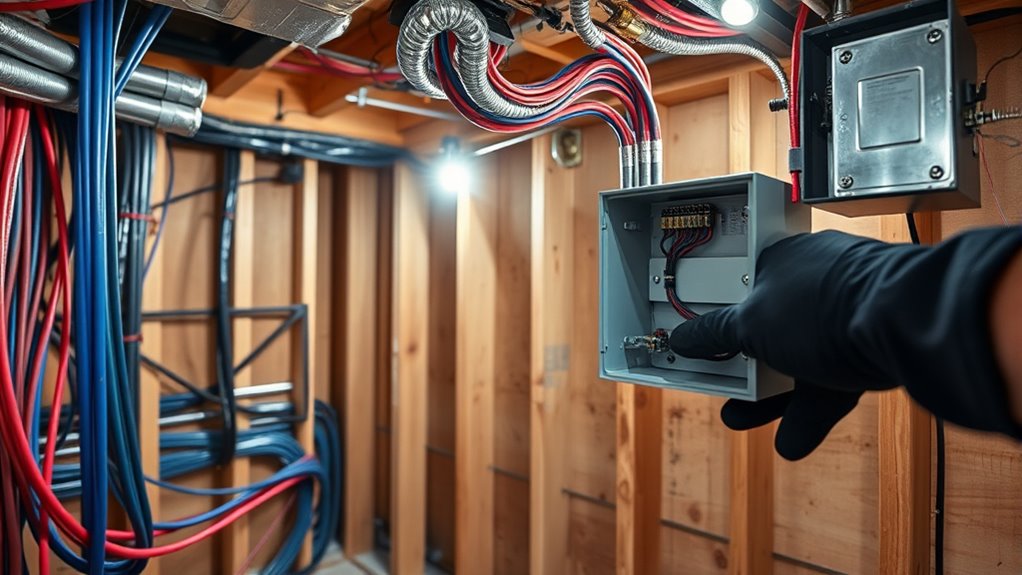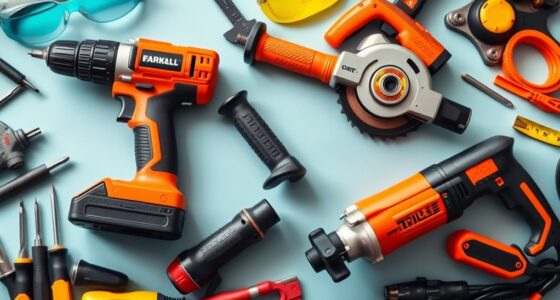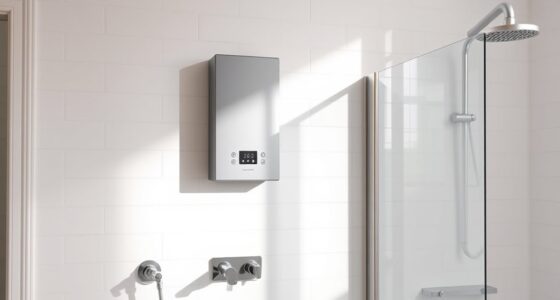Before building your smart home, plan your wiring carefully to guarantee seamless functionality. Install high-quality cables like Cat6 or fiber-optic lines for fast data transfer, and include Power over Ethernet (PoE) for simplified power and data delivery. Use proper safety measures, meet local codes, and incorporate dedicated conduits for future upgrades. Thoughtful layout, organized wiring, and backup power solutions help create a reliable smart home. Keep exploring to learn more about building an efficient wiring system.
Key Takeaways
- Plan for dedicated structured wiring pathways for data, power, and future upgrades during construction.
- Choose high-quality cables like Cat6 and fiber-optic lines for fast, reliable data transmission.
- Install sufficient power sources, including backup solutions, to ensure continuous device operation.
- Separate low-voltage data wiring from electrical wiring to prevent interference and meet safety standards.
- Incorporate proper circuit protection, conduit, and compliance with local building codes for safe, organized installation.

Are you ready to transform your home into a smart, connected space? If so, understanding smart home wiring is essential before you start building or renovating. Proper wiring lays the foundation for seamless automation, reliable data transfer, and future upgrades. The key components include a mix of cables designed for different functions, all organized around a central panel that manages your entire system. This panel acts as the brain of your smart home, coordinating devices and ensuring smooth operation.
Transform your home into a smart, connected space with proper wiring and central system management.
When planning your wiring, you’ll want to use high-performance cables like Cat6 or fiber-optic lines. These are standard for wired networks, providing fast, reliable data transmission that supports everything from streaming to security cameras. Power delivery is equally important, especially with Power over Ethernet (PoE) technology, which supplies both power and data to devices such as security cameras, without cluttering your space with extra power cords. This setup allows for cleaner installations and more efficient use of space.
Safety should always be a top priority. Choosing the right wire gauge and installing circuit protection helps prevent electrical hazards. It’s imperative to meet local building codes and work with qualified electricians to guarantee your wiring is safe and compliant. Proper separation between low-voltage wiring—used for sensors, switches, and data transmission—and standard electrical wiring minimizes interference and enhances safety. Using voltage testers during installation helps you troubleshoot and verify that everything operates correctly. Proper planning and adherence to safety standards are crucial for a reliable smart home system.
Planning your wiring layout is a crucial step. Consider the devices you want to include—such as smart thermostats, security systems, or home entertainment—and assess their power and data needs. For new construction, it’s the perfect time to embed wiring within walls, keeping everything concealed and organized. Structured wiring systems, with dedicated pathways for each cable type, make future expansions simple. For example, coaxial cables support your TV and security cameras, while fiber lines prepare your home for ultra-fast internet speeds down the line.
Reliable power sources are essential for your smart devices to function consistently. Hardwired systems are preferred over battery-powered options for primary operations, providing a steady flow of energy. Some devices require dedicated wiring and neutral wires to operate fully and safely. Backup solutions, like battery-powered devices, are also important, offering resilience during outages. [Including backup power sources can ensure your smart home remains operational during power outages.
Frequently Asked Questions
How Much Does Smart Home Wiring Installation Typically Cost?
You’re probably wondering how much smart home wiring installation costs. Typically, it ranges from $1,500 to over $10,000, depending on your home’s size and the system’s complexity. For an average home, expect to spend between $2,000 and $3,000. Larger homes or those with advanced features will cost more. Keep in mind, labor, hardware, and existing infrastructure also influence the total price.
Can I Upgrade My Wiring After Construction Is Complete?
Like rewriting a story after the final draft, upgrading your wiring post-construction is possible but more challenging. You can update outlets, install smart systems, or rewire specific areas. However, it’s often more disruptive, costly, and complex, requiring invasive techniques. To minimize hassle and expense, it’s best to plan wiring during construction. If you must upgrade later, hire experienced electricians to guarantee safety and seamless integration.
What Are the Best Brands for Smart Home Wiring Components?
When choosing smart home wiring components, you want brands that offer reliability, compatibility, and ease of installation. Lutron Caséta is fantastic for switches and dimmers, especially in older homes. Philips Hue provides dependable smart bulbs, while TP-Link Kasa offers affordable, user-friendly options. For security, Ring and Arlo deliver versatile, easy-to-integrate cameras and systems. Picking these trusted brands guarantees your smart home setup is seamless, reliable, and future-proof.
How Do I Ensure My Wiring Is Future-Proof?
Future-proofing your wiring is like planting a seed for tomorrow’s tech needs. You should run extra cables, install conduit for easy upgrades, and design a scalable system that adapts to new devices. Think ahead with modular wiring, extra outlets, and fiber optic lines. By planning now, you save money and avoid rewiring headaches later, ensuring your home stays ready for whatever tech advancements come next.
Are There Specific Safety Codes for Smart Home Wiring?
You need to follow specific safety codes for smart home wiring. These include adhering to national standards like the NEC, ensuring proper wire types and gauges, and installing circuit protection devices correctly. You should keep wiring secure, insulated, and accessible, and separate low- and high-voltage lines to prevent interference. Make sure grounding and bonding are properly executed, and use certified devices. Regular inspections and permits ensure ongoing safety and code compliance.
Conclusion
Just like Da Vinci sketched the blueprint for greatness, planning your smart home wiring now sets the stage for a future of effortless convenience. Think of it as laying the foundation for your personal Jarvis—seamless, smart, and waiting in the wings. When you wire wisely today, you’re not just building a house; you’re crafting a legacy of innovation and comfort that’ll serve you for years to come. The future’s calling—are you ready to answer?








